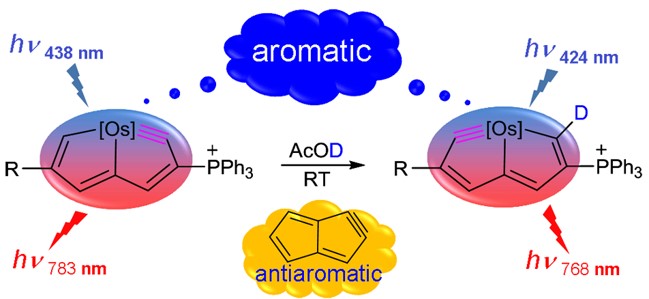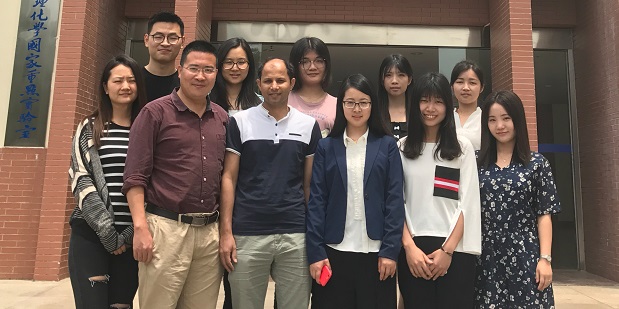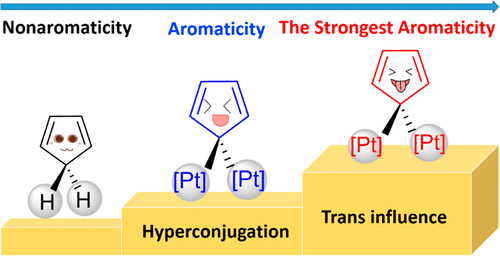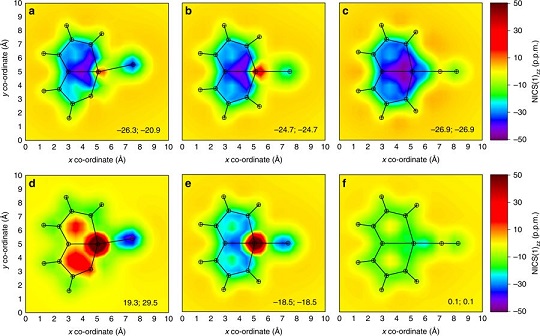Nature Chemistry





Hyperconjugation, an interaction of electrons in a σ orbital or lone pair with an adjacent π or even σ antibonding orbital, can have a strong effect on aromaticity. However, most work on hyperconjugative aromaticity has been limited to main-group substituents. Here, we report a thorough density functional theory study to evaluate the aromaticity in various cyclopentadienes that contain both main-group and transition-metal substituents.

Besides its mathematical importance, the Möbius topology (twisted, single-sided strip) is intriguing at the molecular level, as it features structural elegance and distinct properties; however, it carries synthetic challenges. Although some Möbius-type molecules have been isolated by synthetic chemists accompanied by extensive computational studies, the design, preparation, and characterization of stable Möbius-conjugated molecules remain a nontrivial task to date, let alone that of molecular Möbius strips assembling into more complex topologies.

Hyperconjugation, a weak interaction in organic chemistry, can have a strong effect on aromaticity, leading to the concept of hyperconjugative aromaticity, which was first proposed by Mulliken in 1939. However, most studies are limited to main group chemistry. Here we report the most aromatic and antiaromatic pyrrolium ring by maximizing the hyperconjugation caused by transition metal fragments and the push–pull effect.

Metallaaromatics have attracted considerable interest from both experimentalists and theoreticians since the first prediction of metallabenzenes, in which a CH group is replaced by a transition metal fragment. In comparison with monocyclic metallabenzenes and bicyclic metallanaphthalenes, tricyclic metallaanthracenes are quite less developed. Thus, it is urgent to explore synthetic methods for this rare system. Here we report a thorough investigation on the formation of metallaanthracenes from transition metal fluorenyl complexes via density functional theory calculations.

Carbon ligands have long played an important role in organometallic chemistry. However, previous examples of all‐carbon chelating ligands are limited. Herein, we present a novel complex with an eleven‐atom carbon chain as a polydentate chelating ligand. This species was formed by the [2+2+2] cycloaddition reaction of two equivalents of an alkyne with an osmapentalyne that contains the smallest carbyne bond angle (127.9°) ever observed. Density functional calculations revealed that electron‐donating groups play a key role in the stabilization of this polydentate carbon‐chain chelate.

Isolation of the simplest 4π three‐membered heterocycles (1H‐azirine, oxirene, thiirene, and selenirene) remains a big challenge due to their π‐antiaromaticity and significant ring strain. Here we demonstrate that the incorporation of a transition‐metal fragment could stabilize the antiaromatic selenirene and pentalene frameworks simultaneously by density functional theory (DFT) calculations. Experimental verification leads to the Se‐containing metallapolycycles, osmapentaloselenirenes, with remarkable thermal stability.

Aromaticity is a fundamental chemical concept of ever-increasing diversity. According to Hückel’s and Baird’s rules, cyclic conjugated species with 4n+2 π-electrons are aromatic in the singlet electronic ground state (S0) and antiaromatic in the lowest triplet state (T1), and vice-versa. Thus, species with aromaticity in both states have not yet been reported.

Metal-ligand multiple bonds have received significant attention in the past few decades. A series of novel species with lanthanide-ligand multiple bonds have recently been isolated. This short review summarizes the synthesis and reactivity of these novel complexes.
https://www.sciencedirect.com/science/article/pii/S0040403917316234

Aromaticity, one of the central topics in chemistry, has attracted continuing interest of both experimentalists and theoreticians.

Although the formation of metal–carbon σ bonds is a fundamental principle in organometallic chemistry, the direct bonding of one organic molecule with one metal center to generate more than two metal–carbon σ bonds remains a challenge. Herein, we report an aromaticity-driven method whereby multiyne chains are used to construct three metal–carbon σ bonds in a one-pot reaction under mild conditions. In this method, multiyne chains act as ligand precursors capable of chelating an osmium center to yield planar metallapolycycles, which exhibit aromaticity and good stability.
Copyright © 2025,
Theme Originally Created by Devsaran
